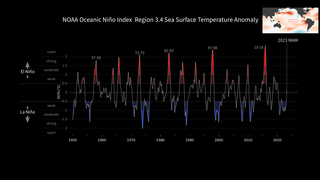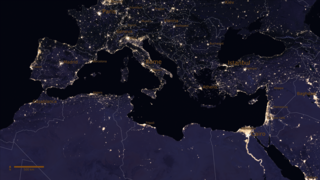Earth
ID: 30976
The Oceanic Niño Index (ONI) is is NOAA's primary indicator for monitoring El Niño and La Niña, which are opposite phases of the climate pattern called the El Niño-Southern Oscillation, or “ENSO” for short.
The ONI is the difference between a three month running average of the sea surface temperature averaged over an area of the ocean from 120 West to 170 West longitude along the equator and the long term average for the same three months.
NOAA considers El Niño conditions to be present when the Oceanic Niño Index is +0.5 or higher, indicating the east-central tropical Pacific is significanty warmer than usual. La Niña conditions exist when the Oceanic Niño Index is -0.5 or lower, indicating the region is cooler than usual.
Oceanic Niño Index through May 2018
The ONI is the difference between a three month running average of the sea surface temperature averaged over an area of the ocean from 120 West to 170 West longitude along the equator and the long term average for the same three months.
NOAA considers El Niño conditions to be present when the Oceanic Niño Index is +0.5 or higher, indicating the east-central tropical Pacific is significanty warmer than usual. La Niña conditions exist when the Oceanic Niño Index is -0.5 or lower, indicating the region is cooler than usual.
Older Version
For More Information
Credits
Marit Jentoft-Nilsen: Visualizer
Please give credit for this item to:
NASA
NASA
Short URL to share this page:
https://svs.gsfc.nasa.gov/30976
Keywords:
SVS >> HDTV
SVS >> Sea Surface Temperature Anomaly
GCMD >> Earth Science >> Climate Indicators >> Teleconnections >> El Nino Southern Oscillation
GCMD >> Earth Science >> Oceans >> Ocean Temperature >> Sea Surface Temperature
SVS >> Hyperwall
NASA Science >> Earth
GCMD >> Earth Science >> Climate Indicators >> Atmospheric/ocean Indicators >> Sea Surface Temperature Indices
GCMD keywords can be found on the Internet with the following citation: Olsen, L.M., G. Major, K. Shein, J. Scialdone, S. Ritz, T. Stevens, M. Morahan, A. Aleman, R. Vogel, S. Leicester, H. Weir, M. Meaux, S. Grebas, C.Solomon, M. Holland, T. Northcutt, R. A. Restrepo, R. Bilodeau, 2013. NASA/Global Change Master Directory (GCMD) Earth Science Keywords. Version 8.0.0.0.0
https://svs.gsfc.nasa.gov/30976
Keywords:
SVS >> HDTV
SVS >> Sea Surface Temperature Anomaly
GCMD >> Earth Science >> Climate Indicators >> Teleconnections >> El Nino Southern Oscillation
GCMD >> Earth Science >> Oceans >> Ocean Temperature >> Sea Surface Temperature
SVS >> Hyperwall
NASA Science >> Earth
GCMD >> Earth Science >> Climate Indicators >> Atmospheric/ocean Indicators >> Sea Surface Temperature Indices
GCMD keywords can be found on the Internet with the following citation: Olsen, L.M., G. Major, K. Shein, J. Scialdone, S. Ritz, T. Stevens, M. Morahan, A. Aleman, R. Vogel, S. Leicester, H. Weir, M. Meaux, S. Grebas, C.Solomon, M. Holland, T. Northcutt, R. A. Restrepo, R. Bilodeau, 2013. NASA/Global Change Master Directory (GCMD) Earth Science Keywords. Version 8.0.0.0.0












